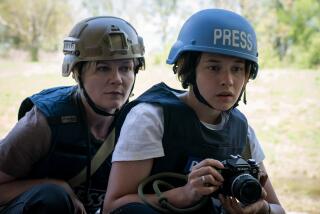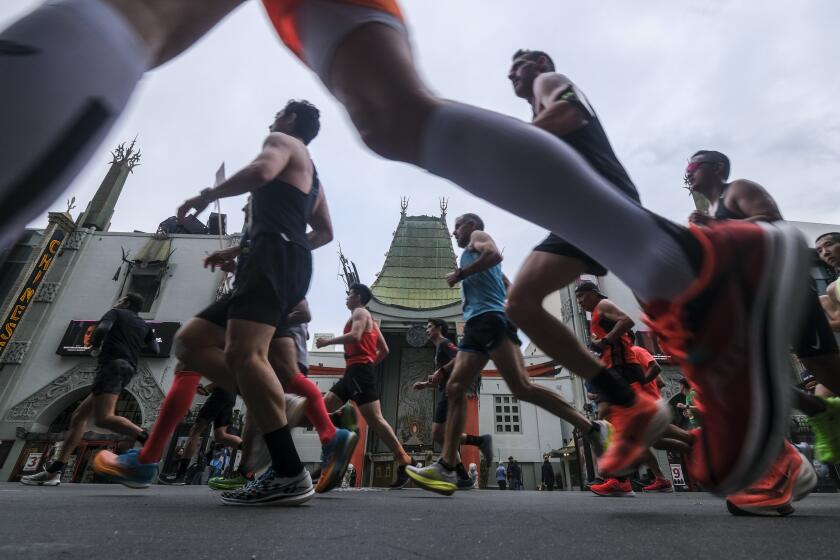Journalism Credibility Gets Big Workout in ‘Mad City’
- Share via
Like the reporters whose exploits it details, a film about journalism has to maintain credibility or it has nothing at all. Director Costa-Gavras and stars Dustin Hoffman and John Travolta give “Mad City” a base of believability but it’s not fated to last.
Costa-Gavras directed and co-wrote the electric “Z,” but that was back in 1970. Here, working from a script by Tom Matthews, he’s made a film that has more in common with Billy Wilder’s celebrated 1951 “Ace in the Hole,” starring Kirk Douglas as a journalist who wouldn’t hesitate to auction off his mother if it helped him get a story.
But what seemed prescient nearly half a century ago now comes off as predictable, simplistic and tame. “Mad City” is an example of how enervated polemical filmmaking can become when its plot loses contact with plausibility. While a case could be made for each of the elements of this worst-case scenario happening, putting them all into the same story is a flagrant case of piling on.
“Mad City” opens with what looks like a carefully planned robbery of a savings institution in fictional Madeline, Calif., but it’s only a local news team from KXBD Channel 6 trying to get a hit-and-run interview from a recalcitrant bank official.
Leading that attack is the ever-brash Max Brackett (Hoffman). Once a nationally known network reporter based in Manhattan, Brackett has been exiled to Madeline for offenses not immediately revealed, and he’s desperate enough to try anything to get back.
Attempting to control Brackett is weary editor Lou Potts (Robert Prosky). While the reporter wants to move the line that defines acceptable journalistic behavior, the editor worries about what the community will think. And when Brackett gets too pushy, Potts sends him and dewy-eyed intern Laurie (Mia Kirshner) to do a puff piece on budget cuts at the local Museum of Natural History.
Simultaneously headed for the museum is recently laid off $8-an-hour security guard Sam Baily (Travolta). All he wants is the chance to plead with Mrs. Banks (Blythe Danner), the museum’s patrician director, for his old job. But when she tries to throw him out Baily takes an automatic weapon from his bag, waves it around, shoots someone and ends up, much to his chagrin, as a takeover artist with a bunch of schoolchildren as hostages.
A lost soul who couldn’t be more hapless as a criminal mastermind, Sam is way out of his depth from minute one of these misadventures. All he wants is the status quo, and when he sees himself castigated on TV for his part in the shooting, he angrily scolds the talking head, “It was an accident, moron.”
The reason Sam Baily is on TV at all is that Max Brackett just happened to be occupied in the men’s room when the weapon went off. After alerting his station, Brackett proceeds to mentor Baily in the finer points of hostage-taking, advising him whom to talk to, what to say to them, what to ask for and how to get it. As to what the reporter wants, that’s clear to us if not to Baily: a story hot enough to get him back to New York.
Under Brackett’s expert manipulation, the saga of Sam Baily gets increasingly bigger until it turns into just the kind of bogus human drama that catches the attention of the network boys in New York. Much against his will, it even piques the interest of Brackett’s nemesis, anchor Kevin Hollander (Alan Alda), “the man America trusts for news” and the reason Brackett is in exile in the first place.
Though its basic situation is hardly new, “Mad City” does have something going for it. While Travolta looks as uncomfortable in his part as his character does brandishing an automatic weapon, Hoffman, who was originally thought of for the Baily role, does excellent work as the newsman, giving a sharp, focused and intelligent performance that adds a note of complexity to a film that generally does without it.
The problem with “Mad City” is that in its eagerness to make its point about journalistic excess as strong as possible, the film just about buries it. Everyone from the FBI to militant militias shows up and everything that can possibly go wrong with the coverage does, from bogus accusations of prejudice to complete strangers being interviewed as Baily’s friends.
Reporters sneak into hospital rooms, trample on flower gardens, and even innocent young intern Laurie gets turned into a conniving careerist in the blink of an eye. Everyone hustles, manipulates and looks for the exploitable angle, which makes them not all that much different from the people responsible for this trying film.
* MPAA rating: PG-13, for depiction of a hostage situation, including violence and brief language. Times guidelines: The violence is brief and not exploited.
(BEGIN TEXT OF INFOBOX / INFOGRAPHIC)
‘Mad City’
Dustin Hoffman: Max Brackett
John Travolta: Sam Baily
Alan Alda: Kevin Hollander
Mia Kirshner: Laurie
Robert Prosky: Lou Potts
Blythe Danner: Mrs. Banks
An Arnold Kopelson production, in association with Punch Productions, released by Warner Bros. Director Costa-Gavras. Producers Arnold Kopelson, Anne Kopelson. Executive producers Wolfgang Glattes, Stephen Brown, Jonathan D. Krane. Screenplay Tom Matthews. Story Tom Matthews & Eric Williams. Cinematographer Patrick Blossier. Editor Francoise Bonnot. Costumes Deborah Nadoolman. Music Thomas Newman. Production design Catherine Hardwicke. Art director Ben Morahan. Set decorator Jan Pascale. Running time: 1 hour, 54 minutes.
* In general release throughout Southern California.
More to Read
Only good movies
Get the Indie Focus newsletter, Mark Olsen's weekly guide to the world of cinema.
You may occasionally receive promotional content from the Los Angeles Times.











